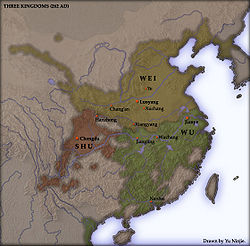Eastern Wu
|
|||||||||||||||||||||||||||||||||||||||||
Eastern Wu (simplified Chinese: 东吴; traditional Chinese: 東吳; pinyin: Dōng Wú), also known as Sun Wu (simplified Chinese: 孙吴; traditional Chinese: 孫吳; pinyin: Sūn Wú), was one of the Three Kingdoms competing for control of China after the fall of the Han Dynasty in the Jiangnan (Yangtze Delta) region of China. During its existence, its capital was largely at Jianye (建業), modern Nanjing), but at times was at Wuchang (武昌, in modern Ezhou, Hubei).
Contents |
History
During the decline of the Han dynasty, the region of Wu - a region in the south of the Yangtze River surrounding Nanjing - was under the control of the warlord Sun Quan. Sun Quan succeeded his brother Sun Ce as the lord over the Wu region paying nominal allegiance to Emperor Xian of Han (who was, at that point, under the control of Cao Cao). Unlike his competitors, he did not really have the ambition to be Emperor of China. However, after Cao Pi of Cao Wei and Liu Bei of the Shu Han each declared themselves to be the Emperor, Sun Quan decided to follow suit in 229, claiming to have founded the Wu Dynasty.
Sun Quan's long reign resulted in the stabilizing of the south. Wu and Shu had a military alliance, to defeat Wei in the north. Wu never managed to gain territory north of the Yangtze river, but Wei never managed to take territory south of the river.
Eastern Wu was finally conquered by the first Jin emperor, Sima Yan, in 280. Wu was the longest-lived of the three kingdoms.
Legacy
Under the rule of Eastern Wu, the Yangtze River Delta region, regarded in early history as a barbaric "jungle" developed into one of the commercial, cultural, and political centers of China. Within five centuries, during the Five Dynasties and Ten States, the development of Southern China centered around Jiangnan had surpassed that of the north. The achievements of Wu marked the beginning of the cultural and political division between Northern and Southern China that would repeatedly appear in Chinese history well into modernity.
The island of Taiwan may have been first reached by the Chinese during the Three Kingdoms period. Contacts with the native population and the dispatch of officials to an island named "Yizhou" (夷州) by the Eastern Wu navy might have been to Taiwan, but the location of Yizhou is open to dispute; some historians believe it was Taiwan, while others believe it was the Ryūkyū Islands.
List of sovereigns
| Posthumous Names ( Shi Hao 諡號) | Personal names | Year(s) of Reigns | Era Names (Nian Hao 年號) and their range of years |
|---|---|---|---|
| Convention: use personal name | |||
| Da Di (大帝 dà dì) | Sun Quan (孫權 sūn quán) | 222-252 |
Huangwu (黃武 huáng wǔ) 222-229 |
| Kuaiji Wang (會稽王 kuaì jī wáng) | Sun Liang (孫亮 sūn liàng) | 252-258 |
Jianxing (建興 jiàn xīng) 252-253 |
| Jing Di (景帝 jǐng dì) | Sun Xiu (孫休 sūn xiū) | 258-264 | Yong'an (永安 yǒng ān) 258-264 |
| Wucheng Hou (烏程侯 wū chéng hóu) or Guiming Hou (歸命侯; gūi mìng hóu) |
Sun Hao (孫皓 sūn haò) | 264-280 |
Yuanxing (元興 yuán xīng) 264-265 |
Gallery
 Jar with modeled figurines from Eastern Wu, 222-280 CE, Shanghai Museum. |
See also
- Shu Han
- Cao Wei
- Three Kingdoms
- Personages of the Three Kingdoms
- Timeline of the Three Kingdoms period
- Romance of the Three Kingdoms
- Records of Three Kingdoms
- Dynasty Warriors
|
|||||||||||||||||
|
|||||||||||||||||
